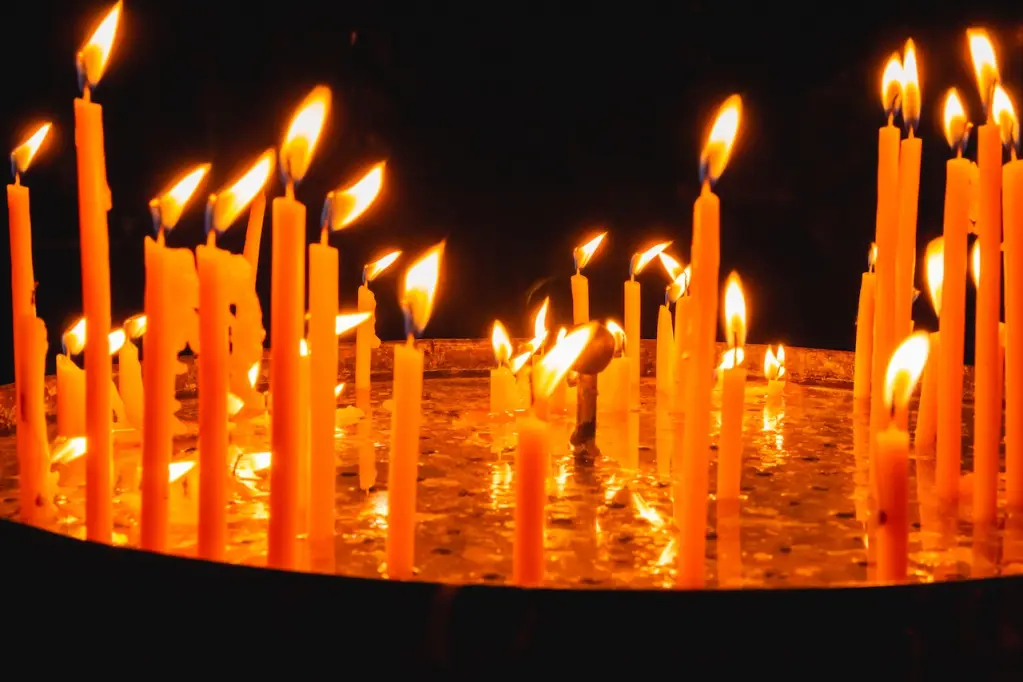Candles flicker without wind due to heat-generated air currents altering the flame’s light path.
Candles have been a light source for centuries, casting their warm glow and creating a peaceful ambiance. One peculiar phenomenon often observed when candles burn is their flickering, even in the absence of any wind or draft.
This seemingly mysterious behavior has captured the curiosity of many, prompting the question: “Why do candles flicker when there is no wind?”
It involves the complex interplay of various factors, including the composition of the candle, air currents generated by the flame’s heat, and the delicacy of the combustion process.
Understanding the science behind this flickering effect can shed light on the captivating dance of flames and enhance our appreciation for candlelight’s simple yet enchanting beauty.
Why Do Candles Flicker When There Is No Wind? Some Distinctive Factors

Candles have a certain mesmerizing quality, especially when their flames flicker and dance, seemingly defying the laws of nature. It is intriguing to witness this phenomenon, especially when there is no wind present.
So, why do candles flicker when there is no Wind? While the absence of wind may lead us to believe that it is the primary cause for the flickering, the reality is more intricate, involving complex physics and the candle’s own behavior.
Convection Currents:
The heat of the candle flame heats the surrounding air, causing it to rise. It consequently, creates convection currents that disturb the flame’s stability.
Microscopic Air Movements:
Even in seemingly still air, tiny air currents are caused by temperature variations and indoor movements, affecting the flame.
Combustion Instabilities:
The combustion process itself can lead to fluctuations in heat and gas flow, resulting in flickering.
Vaporization of Wax:
Uneven vaporization of the candle’s wax can lead to varying fuel supply, impacting the flame’s steadiness.
Wax Pool Ripples:
The liquid wax pool around the wick can create ripples and disturbances as it heats unevenly.
Candle Geometry:
The shape and design of the candle can influence how air flows around the flame, affecting its stability.
Drafts from Surfaces:
Heat can create localized drafts as it rises and interacts with surfaces, creating air movements that affect the flame.
Vibrations:
Vibrations from nearby sources, such as footsteps or machinery, can subtly affect the air around the candle.
Candle Soot:
Soot particles emitted during combustion can interact with the flame, causing temporary changes in its appearance.
Candle Quality:
Variations in wick quality, wax composition, and manufacturing can contribute to flickering tendencies.
Chemical Reactions:
Complex chemical reactions occurring within the flame can lead to momentary fluctuations in combustion and light emission.
Thermal Expansion:
Temperature differences can lead to thermal expansion and contraction of materials around the flame, causing slight air movements.
Gravity Effects:
Microscopic changes in air density due to temperature can create minute buoyancy effects, influencing the flame’s movement.
Moisture in the air:
High humidity levels in the room can introduce moisture into the candle’s flame, causing it to flicker. This effect is more pronounced in candles made with natural materials, as they can be more sensitive to moisture.
The potential significance of flickering candles in superstitions and spiritual beliefs

Flickering candles have held diverse meanings in superstitions and spiritual beliefs across cultures, often interpreted as messages or omens from the spiritual realm:
Spiritual Presence: Flickering candles are seen as a sign of spiritual beings or deities attempting to communicate with the physical world.
Divination: Candle behavior is believed to provide insights into the future. A steady flame might signify positive outcomes, while erratic flickering could indicate challenges.
Guidance and Protection: Flickering flames are thought to symbolize the presence of guiding spirits, offering protection and assistance to individuals.
Manifestation: Candle flickering is linked to manifesting intentions, desires, or prayers, suggesting that the universe is aligning with one’s wishes.
Energy and Vitality: Vibrant flickering flames can represent an individual’s energy or life force, reflecting their spiritual vitality.
Astral Communication: In some practices, candle flickering is considered a means of communication with astral beings or interdimensional entities.
Transition and Transformation: Flickering flames are associated with transitions, signaling shifts in life situations or spiritual states.
Cleansing and Purification: Flickering candles are thought to cleanse spaces of negative energy, enabling spiritual purification and renewal.
Acknowledgment of Prayer: Candle flickering can be interpreted as acknowledgment from higher powers that prayers or intentions have been received.
Balance and Harmony: Flickering flames symbolize the delicate balance between the physical and spiritual realms, reflecting the interconnectedness of existence.
Enhanced Intuition: The behavior of a candle flame is believed to enhance one’s intuitive abilities, facilitating deeper insights and heightened awareness.
Signs from Deceased Loved Ones: Flickering candles are often associated with messages from departed loved ones, signifying their continued presence and connection.
Open Channels to the Divine: Flickering candles are seen as opening channels for communication between the mortal and divine realms.
Symbolic Omens: Interpretations of flickering patterns vary widely. A strong, steady flame may indicate positive outcomes, while a sudden extinguishing might be seen as a warning.
Spiritual Transformation: Flickering candles are believed to accompany spiritual growth, evolution, or enlightenment periods.
Alignment with Cosmic Forces: Flickering flames are thought to align with celestial forces or planetary energies, influencing events and outcomes.
FAQs
Can indoor air conditioning or heating affect candle flickering?
Yes, temperature differentials caused by HVAC systems can create air currents, leading to candle flickering.
Are certain candle waxes or wicks more prone to flickering?
Yes, wick size, composition, and wax type can influence flickering tendencies. Thicker wicks and certain wax blends might reduce flickering.
How does candle placement affect flickering?
Candles near open windows, vents, or drafts are likelier to flicker due to increased air movement.
Are there ways to minimize flickering for a steadier candle flame?
Using stable holders, trimming wicks, and placing candles away from direct airflow can help reduce flickering.
Does flickering affect a candle’s burn time or performance?
Flickering might lead to uneven burning and faster candle consumption, potentially affecting overall performance.
Can flickering be eliminated entirely?
While complete elimination may be challenging, minimizing sources of air movement and using appropriate candle accessories can significantly reduce flickering.
Are electric or LED candles prone to flickering as well?
Electric or LED candles are less likely to flicker as they don’t rely on combustion for illumination.
Is flickering a sign of an issue with the candle?
Flickering in the absence of wind is usually normal. However, excessive flickering might indicate a wick that’s too long or other burning issues.
Are there artistic or aesthetic reasons to enjoy candle flickering? Yes, the gentle dance of a flickering flame can create a cozy ambiance and add to the charm of candlelit settings.
Conclusion
It’s important to recognize that interpretations of flickering candles vary greatly among cultures and belief systems.
While these beliefs can hold personal and cultural significance, they should be approached with an open mind and understanding of the underlying physics influencing candle behavior.
So, why do candles flicker when there is no wind?
Candles flicker without wind due to heat-generated convection currents, wax vaporization, wick interactions, and indoor micro-movements affecting the flame’s stability.

